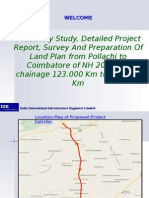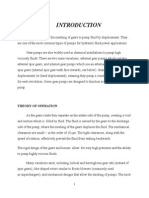External Vs Internal Gear Design
External Vs Internal Gear Design
Uploaded by
Samad A BakarCopyright:
Available Formats
External Vs Internal Gear Design
External Vs Internal Gear Design
Uploaded by
Samad A BakarOriginal Description:
Original Title
Copyright
Available Formats
Share this document
Did you find this document useful?
Is this content inappropriate?
Copyright:
Available Formats
External Vs Internal Gear Design
External Vs Internal Gear Design
Uploaded by
Samad A BakarCopyright:
Available Formats
Comparison between an external gear design pump &
an internal gear design pump.
External Gear pump Internal Gear pump
1. A pair of external gear forms the 1. An internal gear & a external gear
rotor. form the rotor of the pump.
2. There are four bearing supporting 2. Rotor is generally supported on
the rotor shafts. one bearing or at the most two
bearings.
3. L/D ratio of the rotor can be 3. The L/D ratio is hardly 1 or even
maintained as high as 3. less.
4. Due to high L/D ratio & due to 4. Due to low L/D ratio & capacity
two gear the capacity transfer per determined by one gear the rotor
unit size is very high hence the size is fairly high for unit capacity,
pump is more compact & efficient. due to this the pump is bulky &
even inefficient for higher models.
5. Due to advantage on rotor design 5. Due to limitation on rotor design
pumps up to 12" size with the pump size is restricted up to 2"
capacity up to 500 M3/hr. are with capacity up to 15 M3/hr.
designed & manufactured.
6. External gear pumps are 6. Internal gear pumps are
recommended for loading, un- recommended for high-pressure
loading & transfer application for fuel pressurizing application for
bulk cargo. boiler, burner & in P&H units.
7. It is possible to offer external gear 7. The gears are only spur, further a
design pump with spur, helical or wedged is required to separate the
herringbone gear design. two gears.
8. Very wide application from engine 8. Limited application for small
lubrication to cargo unloading capacities & moderate pressure.
You might also like
- Robo Lvac Voice Nuo UMDocument44 pagesRobo Lvac Voice Nuo UMAyesha50% (2)
- National IndustriesDocument10 pagesNational IndustriesKishan makvanaNo ratings yet
- Bommanahalli Guidance Value PDFDocument13 pagesBommanahalli Guidance Value PDFAnonymous 8fxQep0% (2)
- E Rickshaw (Electric Tuk Tuks) Manufacturing Business 74545Document65 pagesE Rickshaw (Electric Tuk Tuks) Manufacturing Business 74545Nikita MotwaniNo ratings yet
- HCL FinalDocument92 pagesHCL Finalmonika_patodiaNo ratings yet
- Yamamoto Brochure ENG RevDocument6 pagesYamamoto Brochure ENG Revsrinath Kandregula100% (1)
- VD2019 01.07.2019 Rev.6Document223 pagesVD2019 01.07.2019 Rev.6qc deNo ratings yet
- Shell Production RailwayDocument95 pagesShell Production RailwayaravindanNo ratings yet
- Name of StateDocument10 pagesName of StatesawshivNo ratings yet
- E - Rickshaws Annexures - IUTDocument90 pagesE - Rickshaws Annexures - IUTANIL KUMARNo ratings yet
- DistributorsDocument26 pagesDistributorsUmesh ParyaniNo ratings yet
- Rudrapur DDocument3 pagesRudrapur Dtecbatch1No ratings yet
- Reo Parts Price List FY 23Document4 pagesReo Parts Price List FY 23Akhil josephNo ratings yet
- Design of Gears For Drilling MachineDocument10 pagesDesign of Gears For Drilling MachineRohan Julian FrancisNo ratings yet
- Mumbai-Nagpur Expressway All PackagesDocument6 pagesMumbai-Nagpur Expressway All PackagesVignesh ChettiyarNo ratings yet
- Welcome To UjaasDocument14 pagesWelcome To UjaasAshutosh JangidNo ratings yet
- FiemDocument39 pagesFiemyesitsarihantNo ratings yet
- Gears Manufacturers in IndiaDocument19 pagesGears Manufacturers in IndiaHind GearNo ratings yet
- Tata, TipperDocument95 pagesTata, Tippermonika_richaNo ratings yet
- Operations and Supply Management Individual ReportDocument10 pagesOperations and Supply Management Individual ReportKartik RajpurohitNo ratings yet
- 24 1 2013 21 41 9 Mining - LeasesDocument41 pages24 1 2013 21 41 9 Mining - LeasesRomi SNo ratings yet
- Tender Status Report Delhi-Mumbai Expressway 10.01.19Document66 pagesTender Status Report Delhi-Mumbai Expressway 10.01.19chtrp100% (2)
- Greaves FINALDocument51 pagesGreaves FINALmukesh singh aimkNo ratings yet
- QR Codes - Print & ShipDocument1,081 pagesQR Codes - Print & Shipramansharma1769No ratings yet
- JaiRaj AncillariesDocument8 pagesJaiRaj Ancillariestajju_121No ratings yet
- Drawing of Toll BoothDocument1 pageDrawing of Toll Boothchiranjeevimd2991 MDNo ratings yet
- 0118 Gearsolutions PDFDocument60 pages0118 Gearsolutions PDFdesetekNo ratings yet
- Mahindra Price ListDocument4 pagesMahindra Price ListYo PaisaNo ratings yet
- Top Performing Auto Components Manufacturing Companies - GujaratDocument3 pagesTop Performing Auto Components Manufacturing Companies - GujaratSWAPNILNo ratings yet
- RFP Modified Schedule A, B, C DDocument94 pagesRFP Modified Schedule A, B, C DRavishankar HobannaNo ratings yet
- Ac Generator ReferenceDocument14 pagesAc Generator ReferenceSudhi81No ratings yet
- MAK Lubricants - Price ListDocument4 pagesMAK Lubricants - Price Listhajari100% (3)
- List of MinesDocument12 pagesList of Minessabka632No ratings yet
- Is 278 2009 PDFDocument11 pagesIs 278 2009 PDFjaianit89No ratings yet
- Price List Wef 16th Jan 2024Document2 pagesPrice List Wef 16th Jan 2024Realm PhangchoNo ratings yet
- NH 209Document30 pagesNH 209Mohammed Zuber InamdarNo ratings yet
- Conso GarageListDocument180 pagesConso GarageListTushar PokharnikarNo ratings yet
- Hemco Engineering Private Limited PDFDocument4 pagesHemco Engineering Private Limited PDFakarshverma01No ratings yet
- Tender DocumentDocument21 pagesTender DocumentparthibanptrafficNo ratings yet
- On HMT PVT. LTD.Document28 pagesOn HMT PVT. LTD.Mohit Kumar100% (1)
- Bombay Non Ferrous Metals Association LTDDocument43 pagesBombay Non Ferrous Metals Association LTDindoreinfolineofficeNo ratings yet
- Vandan Industries Purchase OrderDocument2 pagesVandan Industries Purchase OrderVijay MummigattiNo ratings yet
- ARS-2023-24-38 With EwayDocument4 pagesARS-2023-24-38 With EwaypmmahobaNo ratings yet
- Details of 2 Wheeler Companies in IndiaDocument32 pagesDetails of 2 Wheeler Companies in Indiaapurva_chunarkarNo ratings yet
- FTR TEST REPORT OF MAHINDRA 605 DI I Aug 2020Document57 pagesFTR TEST REPORT OF MAHINDRA 605 DI I Aug 2020Mekh MitraNo ratings yet
- Coal Mines in India-2014Document3 pagesCoal Mines in India-2014iData InsightsNo ratings yet
- Material Handling India PDFDocument7 pagesMaterial Handling India PDFsangeeth_7No ratings yet
- 343 Tender Hardware ItemsDocument106 pages343 Tender Hardware Itemssolid_impact100% (1)
- Eicher Pro 6041Document1 pageEicher Pro 6041Rohit ChatterjeeNo ratings yet
- Kuldip NayarDocument160 pagesKuldip Nayararihant awasthiNo ratings yet
- Client Clarification Steel Hypermart TNDocument2 pagesClient Clarification Steel Hypermart TNSURANA1973No ratings yet
- Amardeep Master Catalogue PDFDocument220 pagesAmardeep Master Catalogue PDFAmit VermaNo ratings yet
- Cummins 380KVA QuotationDocument1 pageCummins 380KVA QuotationabhibawaNo ratings yet
- Gear Pump Design: Using AGMA MethodDocument28 pagesGear Pump Design: Using AGMA Method20M130 - MUKUNTH A GNo ratings yet
- Selecting Positive Displacement PumpsDocument4 pagesSelecting Positive Displacement PumpsArindam GhosalNo ratings yet
- Gear Pump OperationDocument7 pagesGear Pump Operationahmed el sayedNo ratings yet
- Diff Types of PD PumpsDocument6 pagesDiff Types of PD PumpsdhakshuNo ratings yet
- Turbo Manifold Designs by Engine BasicsDocument17 pagesTurbo Manifold Designs by Engine BasicsJam Bab100% (1)
- Gear PumpsDocument15 pagesGear PumpsPrince ShanNo ratings yet
- All types of pumpsDocument2 pagesAll types of pumpsParth chavanNo ratings yet
- Operator'S Manual Diesel Engine: Creating Power SolutionsDocument105 pagesOperator'S Manual Diesel Engine: Creating Power SolutionsSamad A BakarNo ratings yet
- Catridges ValvesDocument316 pagesCatridges ValvesSamad A Bakar100% (1)
- Stauff Sensor PDFDocument96 pagesStauff Sensor PDFSamad A BakarNo ratings yet
- Stauff Sensor PDFDocument96 pagesStauff Sensor PDFSamad A BakarNo ratings yet
- E5204-1!12!10 Valve Stacking System LDocument13 pagesE5204-1!12!10 Valve Stacking System LSamad A BakarNo ratings yet
- Damping Ring InstallationDocument6 pagesDamping Ring InstallationSamad A BakarNo ratings yet
- Hydac Ball ValvesDocument6 pagesHydac Ball ValvesSamad A BakarNo ratings yet
- Testpoint.: The Compact, Quick Fastening Measurement CouplingDocument10 pagesTestpoint.: The Compact, Quick Fastening Measurement CouplingSamad A BakarNo ratings yet
- WalvoilDocument64 pagesWalvoilSamad A BakarNo ratings yet
- E5255 HSBDocument8 pagesE5255 HSBSamad A BakarNo ratings yet
- Nivotemp NT 64: Level and Temperature Switch With Display NV64DDocument6 pagesNivotemp NT 64: Level and Temperature Switch With Display NV64DSamad A BakarNo ratings yet
- pRESSURE REDUCING VALVEDocument2 pagespRESSURE REDUCING VALVESamad A BakarNo ratings yet
- Check Valves Direct Acting Cone Poppet Valve For Inline and Manifold Mounting - 350 Bar RV, RVP 06 To 40Document4 pagesCheck Valves Direct Acting Cone Poppet Valve For Inline and Manifold Mounting - 350 Bar RV, RVP 06 To 40Samad A BakarNo ratings yet
- Flanged Ball Valves KHFF: (Also Order Example)Document4 pagesFlanged Ball Valves KHFF: (Also Order Example)Samad A BakarNo ratings yet
- Tente CatalogDocument371 pagesTente CatalogSamad A Bakar0% (1)
- BIS Bladder Integritiy SystemDocument1 pageBIS Bladder Integritiy SystemSamad A BakarNo ratings yet
- FCU1000Document2 pagesFCU1000Samad A BakarNo ratings yet
- Asme Bladder Accumulator DatasheetDocument3 pagesAsme Bladder Accumulator DatasheetSamad A BakarNo ratings yet
- Fluid Monitoring Module FMM: Description Technical SpecificationsDocument8 pagesFluid Monitoring Module FMM: Description Technical SpecificationsSamad A BakarNo ratings yet
- Directional Control ValvesDocument16 pagesDirectional Control ValvesSamad A BakarNo ratings yet
- Screw Pumps 2013Document8 pagesScrew Pumps 2013Samad A BakarNo ratings yet
- E10116 2 0 03 07 - MPV - 6 2 12Document3 pagesE10116 2 0 03 07 - MPV - 6 2 12Samad A BakarNo ratings yet
- Ball ValvesDocument26 pagesBall ValvesSamad A BakarNo ratings yet
- Equipment Sign-Out Form: Office of Student DevelopmentDocument2 pagesEquipment Sign-Out Form: Office of Student DevelopmentSamad A BakarNo ratings yet
- Fluid Power FormulasDocument5 pagesFluid Power FormulasSamad A BakarNo ratings yet
- Arlon TTF BgtsDocument11 pagesArlon TTF BgtsSamad A Bakar100% (1)




















































































